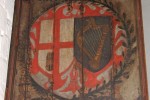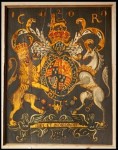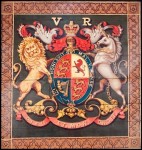The Churches Conservation Trust (CCT), a national charity dedicated to the conservation of England’s historic churches, has created a fascinating interactive online history of the Royal Coat of Arms. The CCT is particularly well-placed to illustrate this history because ever since Henry VIII created the Church of England to secure a divorce, the Royal Arms have been displayed in churches as a pointed symbol of the sovereign’s role as head of the church.
 One hundred of the 340 churches under the CCT’s purview have painted, stone, wooden, plaster, stained glass, tapestry, etc. versions of the Royal Arms inside. The earliest, St. James’ Church in Cameley, dates to the 12th century reign of Richard I (1189-1199), the first monarch to add his heraldry to the Great Seal. Appropriately for a man known by the sobriquet “Lionheart,” his Arms featured three white lions on a red background. They were the first style of the Royal Arms to be used by themselves as Royal Arms, and the three lions of England have been on every Royal Coat of Arms ever since. Click on the picture of the painted lions here to zoom in on it.
One hundred of the 340 churches under the CCT’s purview have painted, stone, wooden, plaster, stained glass, tapestry, etc. versions of the Royal Arms inside. The earliest, St. James’ Church in Cameley, dates to the 12th century reign of Richard I (1189-1199), the first monarch to add his heraldry to the Great Seal. Appropriately for a man known by the sobriquet “Lionheart,” his Arms featured three white lions on a red background. They were the first style of the Royal Arms to be used by themselves as Royal Arms, and the three lions of England have been on every Royal Coat of Arms ever since. Click on the picture of the painted lions here to zoom in on it.
 From Richard I until Henry VIII, the Royal Arms were reserved for the tombs of kings in Westminster Abbey, or for the tombs of noblemen who claimed a family connection to the monarchs in more modest parish churches. For example, the tomb of Sir William Gascoigne, Chief Justice of England under Henry IV, is a carved alabaster monument in All Saints Church, Harewood. The Royal Arms are carved on the foot of the tomb because his first wife, Elizabeth de Mowbray, was descended from the House of Plantagenet.
From Richard I until Henry VIII, the Royal Arms were reserved for the tombs of kings in Westminster Abbey, or for the tombs of noblemen who claimed a family connection to the monarchs in more modest parish churches. For example, the tomb of Sir William Gascoigne, Chief Justice of England under Henry IV, is a carved alabaster monument in All Saints Church, Harewood. The Royal Arms are carved on the foot of the tomb because his first wife, Elizabeth de Mowbray, was descended from the House of Plantagenet.
 The lion and unicorn on either side of the shield (called supporters) were added by King James I, who was also King James VI of Scotland, when he ascended to the throne after Elizabeth I’s death in 1603. The Stuart shield had two silver unicorns supporting it, so as a compromise he added England’s lion to support the left side of England’s shield and the unicorn of Scotland to support the right. As with Richard III’s wild boars, the new supporters were noticeably well-endowed.
The lion and unicorn on either side of the shield (called supporters) were added by King James I, who was also King James VI of Scotland, when he ascended to the throne after Elizabeth I’s death in 1603. The Stuart shield had two silver unicorns supporting it, so as a compromise he added England’s lion to support the left side of England’s shield and the unicorn of Scotland to support the right. As with Richard III’s wild boars, the new supporters were noticeably well-endowed.
 Surprise, surprise, Oliver Cromwell was not a fan. Under the Commonwealth, the Royal Arms were changed to State Arms. No genitals were in evidence. King Charles II brought them back to the Royal Arms with the restoration of the monarchy in 1660 where they remained jutting proudly until the first half of the 19th century. Queen Victoria opted for the Ken doll look.
Surprise, surprise, Oliver Cromwell was not a fan. Under the Commonwealth, the Royal Arms were changed to State Arms. No genitals were in evidence. King Charles II brought them back to the Royal Arms with the restoration of the monarchy in 1660 where they remained jutting proudly until the first half of the 19th century. Queen Victoria opted for the Ken doll look.
 Click through the Evolution of Royal Arms timeline for zoomable images and fascinating details about how the Royal Arms developed over the years in different churches. Each entry has a link to the website of the specific church, so if you want to make an itinerary of Royal Arms visits all the information is at your fingertips.
Click through the Evolution of Royal Arms timeline for zoomable images and fascinating details about how the Royal Arms developed over the years in different churches. Each entry has a link to the website of the specific church, so if you want to make an itinerary of Royal Arms visits all the information is at your fingertips.
 For a quick visual overview of the different Royal Arms from the first official one in 1198 until today’s, see this timeline. The symbols are easier to pick out in the digital renderings than they are in some of the historical shields.
For a quick visual overview of the different Royal Arms from the first official one in 1198 until today’s, see this timeline. The symbols are easier to pick out in the digital renderings than they are in some of the historical shields.
I love this rollover explanation of the modern Royal Arms. You hover over a given part, click on the symbol you’re interested in and a little window pops out with details about that specific element. I had no idea about the mantling. It’s the floral looking scarf attached to the helmet (called the helm) on top of the shield.
The mantling is based on the small cloth or cloak that would hang from a knight’s helmet, over his shoulders, to protect him from the elements. It was often depicted as torn or jagged – perhaps alluding to the cuts and slashes it would have received in battle, which would have greatly enhanced a knight’s reputation on his return home.
There’s also a handy introduction to the many and vast complexities of heraldry, such as the rules governing colors, symbols, division, and how heraldry relays familial histories.
For archaeology nerds, the section on conservation is a must-read. Conservator Sally Woodcock explains how and why many of the Royal Arms in churches have suffered damage over the years, the methods they use to stabilize the pieces and in some cases reverse the damage, and best of all, uses before and after pictures to illustrate the process.
All the information is concise and readable but still detailed and intelligent. It’s an excellent educational resource for young and old alike, because the subject of heraldry can be incredibly daunting to tackle with its arcane nomenclature and dense symbolism. The Churches Conservation Trust has created a practical introduction to the entire field by way of sharing the exceptional examples of Royal Arms in its churches.